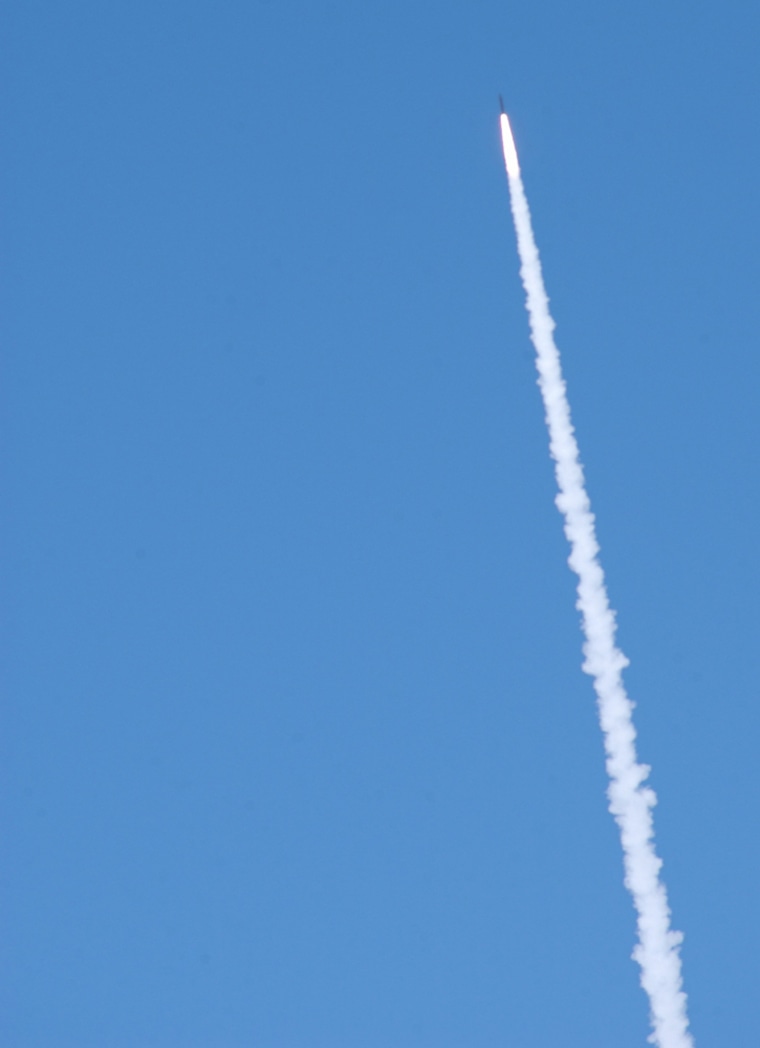An interceptor missile destroyed a mock warhead over the Pacific Ocean on Friday in a key test of the nation’s missile defense system, U.S. military officials said.
It was the most realistic test of the systems that would be used against an attack, said Missile Defense Agency spokesman Rick Lehner.
The 54-foot interceptor shot out of an underground silo at Vandenberg Air Force Base on the central California coast at 10:39 a.m., 17 minutes after the mock warhead was launched from Kodiak Island, Alaska, Lehner said.
The interceptor carried a refrigerator-sized “kill vehicle” that locked on to the approaching mock enemy missile and flew into the 4-foot-long warhead at 18,000 mph.
Lehner said both disintegrated more than 100 miles above the Earth and a few hundred miles west of Vandenberg. The interceptor’s flight lasted 13 minutes.
Test called a ‘total success’
The $85 million test was designed to see whether the “kill vehicle” could get close to the warhead to test the tracking and sensor systems which would be used in an actual missile attack.
“It gave us a good chance to measure overall system performance. It was the most operationally realistic test we’ve had,” Lehner said.
The interceptor was launched by remote control from a command center in Colorado. The test also was the first use of an early warning radar at Beale Air Force Base, Calif., to provide the data required to put the interceptor on a proper path toward its target.
The test was a “total success,” Lt. Gen. Henry A. Obering III, the agency director, told a Pentagon news conference.
“What we did today is a huge step in terms of our systematic approach to continuing to field, continuing to deploy and continuing to develop a missile defense system for the United States, for our allies, our friends, our deployed forces around the world,” Obering said.
Data from the test will take several weeks to review, Lehner said.
Pyongyang reacts
North Korea accused the United States of threatening war against the communist nation with the missile defense test and vowed to strengthen its self-defense to counter any U.S. attack.
Slideshow 12 photos
Month in Space: January 2014
The U.S. move “clearly shows that it is the U.S. which is increasing tensions on the Korean Peninsula and threatening war against our country,” the North’s Committee for the Peaceful Reunification of the Fatherland said in a statement Saturday.
The North will strengthen its “self-defensive deterrent,” said the statement, carried by the official Korean Central News Agency. Pyongyang often uses the phrase to refer to its nuclear program.
Stephen Young, a senior analyst for the Union of Concerned Scientists, a group that advocates curbing the spread of nuclear weapons, said the demonstration was still far from replicating an actual missile attack, he said.
“They know the when, the where, the what (of the target missile) ... where it’s coming from, the size of the warhead,” he said by phone from Maryland.
The test was a small step forward, but the system is still far from being able to protect Americans from long-range missile attacks, said John Pike, director of GlobalSecurity.org, a Washington, D.C., think tank.
“The whole point is for us not to worry about the North Korean missiles,” said Pike. “They are not close to that yet. Whether it will ever happen is subject to debate.”
Weather delayed earlier launch
The launch was postponed from Thursday after fog socked in Kodiak Island. There was also fog over Vandenberg Friday morning but it burned off.
More than $100 billion has been spent on America’s missile-defense system since 1983 and it has been the subject of criticism by those who call it a costly boondoggle. There also have been allegations that early tests were rigged or their success exaggerated. The Pentagon says the technology used in those tests is not part of the current research program.
Critics also argued early on that the end of the Cold War made a full-scale missile attack on the U.S. unlikely. Supporters say the U.S. still is vulnerable to missiles from rogue states.
In July, North Korea unsuccessfully test-fired a missile that was believed capable of reaching the northwestern U.S. coast.
When asked the odds of a U.S. interceptor being able to shoot down a North Korean missile using the existing missile defense system, Obering said the estimate is classified secret.
“But what I will tell you is that this test validated the confidence that I’ve expressed in the past with the performance of the system,” he said.
Asked whether he would rate the chances, broadly speaking, as excellent, good, fair or poor, Obering said, “I think we have a good chance. And it’s one that I feel a lot safer and sleep a lot better at night.”
Defense Secretary Donald H. Rumsfeld said in a statement that he was pleased but would leave it to the experts to characterize the details.
“While today’s test was a success, the test program is by no means complete,” he said. “Tests will continue, some of which will be successful and some will not. This was a challenging test, and the tests will become even more challenging in the period ahead.”
There have been nine intercept tests since 1999, and five were successful in hitting the target, Lehner said. An actual intercept test was scheduled for the end of this year or in early 2007, he said.
Although Obering described the test as realistic, the target missile did not deploy decoys or other devices that might be aboard an actual long-range ballistic missile fired by an attacking country. Obering said decoys or other countermeasures might be added to the next test, scheduled for December.

